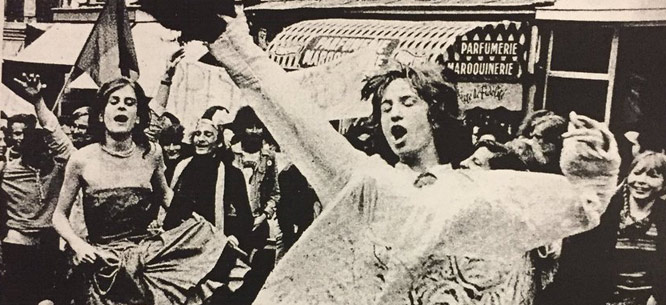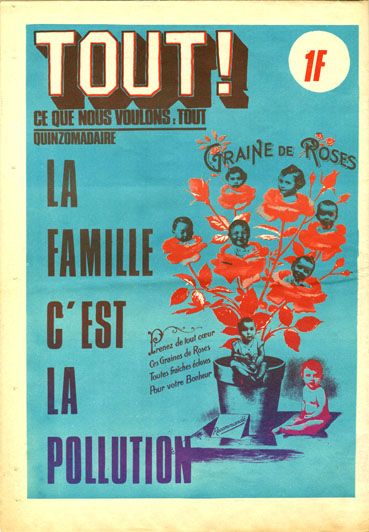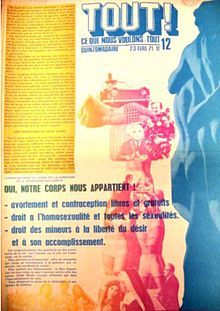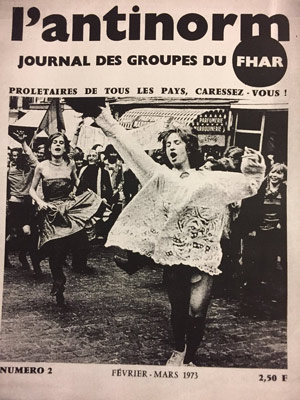Out of the Closet, Into the Streets
Out of the Closet, Into the Streets
The revolutionary fervor of May ’68 didn’t end with a general strike. It fueled radical demands for years to come, and brought new causes into the mainstream—not least of them LGBT rights.

At some point during the early stages of the occupation of the Sorbonne university in Paris, where police repression sparked a nationwide general strike in May 1968, a couple of students hung a provocative poster on the wall just outside the main general assembly. Amid portraits of Marx, Lenin, and Mao, there appeared, briefly, a flier for a “Revolutionary Pederastic Action Committee.” The organization existed only on paper, literally. It denounced repression of “erotic minorities” and called on “pederasts, lesbians, etc.” to express themselves freely.
It took some time, but eventually they did. Alongside the action in factories and streets, May ’68 was an occasion for profound reflection on society’s ills. While France’s protest movement faded quickly, its critical spirit burned on. As is bound to happen when millions of people go on strike together, a considerable number were changed for life. In the following years, some of them turned their attention toward sexuality, the repression thereof, and, eventually, to political action in the field. Much ink has been spilt on the “events” of 1968, but LGBT rights remain an underappreciated part of their legacy.
Longtime leftist activist and writer Daniel Guérin was one of many to come out of the closet in the aftermath of May 1968. As he wrote in his Autobiography of Youth, published in 1972, the movement “allowed many homosexuals to come to terms with themselves.” After spectacularly rebelling in public, it seemed silly to hide one’s own sexual preferences to appease the existing social order.
In 1971, activists created the first organizations explicitly committed to the gay and lesbian causes in France, the Homosexual Front for Revolutionary Action (FHAR) and the Red Dykes (Gouines Rouges), itself an outgrowth of both the FHAR and the Women’s Liberation Movement (MLF). The names sound outlandish today, but they reflect the intensity of political upheaval in France at the turn of the 1970s. Fueled by the sort of expanded political imagination that comes from grinding the economy of a global superpower to a halt, strikes spiked as workers denounced low pay and soul-crushing labor on the assembly line; immigrant activists fought back against racism and poor housing conditions; Maoists, Trotskyists, and anarchists shined light on new “causes” not previously seen as political issues like the environment and the plight of prisoners. Le Monde ran a regular section called “contestation,” chronicling daily strikes and protests. For many of these protagonists, socialist revolution seemed within reach.
Such was the lens through which freshly politicized lesbians and gays began to contemplate their own kind of suffering and exploitation. For them, eradicating discrimination against same-sex desire was incompatible with the existence of capitalism. They were not interested in influencing politicians. They were not interested in winning office. They saw themselves as laying the groundwork for a revolution in gender relations that would accompany the coming political revolt.
In the grand gauchiste tradition, gay activism boiled down to a mix of newspapers, marches, and disruptive public events. FHAR co-founder Guy Hocquenghem edited a special April 1971 edition of Tout! (Everything!) devoted to homosexuality. In the pages of this newspaper run by the short-lived, anarcho-Maoist splinter group Vive la Révolution! (Long Live the Revolution!), gay activists demanded “free abortion and contraception” as well as the “right to homosexuality and to all sexualities.” They broke up a live recording of a nationally-broadcast radio show devoted to the “painful problem of homosexuality.” They marched in the annual May 1 parade in Paris, some going in drag to provoke stodgy leaders of the French Communist Party and its closely linked trade union, the General Confederation of Labor (CGT). They held meetings at the School of Fine Arts in Paris, some of which degenerated into prolonged hook-up sessions and sometimes more than just that. At one such general assembly, writers Daniel Guérin and Françoise d’Eaubonne are said to have stripped naked. These meetings were just as much group therapy sessions as political events, rare moments during which gays and lesbians could congregate, share their deepest anxieties, and dream of a better world.
May 1968 was the de facto reference point for political action. It was seen as both the moment during which people fought back and as the trigger for self-reflection on sexual identity—the beginning, as the saying went, of a “prolonged struggle.” Stonewall filled a similar function on the other side of the Atlantic: a source of pride for a burgeoning circle of gay activists that beckoned toward further direct action and visibility. Much like their French counterparts, these agitators were revolutionaries and they wanted everyone to know it. The name they chose, the Gay Liberation Front, echoed the National Liberation Front of Vietnam, a group ostensibly in struggle for a comparable anticapitalist political ideal, and in the midst of a similarly uphill battle to achieve it.
Covers of Tout! and the FHAR publication L’antinorm. The April 1971 edition of Tout! (center), edited by Guy Hocquenghem, was banned on grounds of being pornographic.
Many of these radical activists, in France as in the United States, had messy politics. The Red Dykes themselves were created as a splinter group in response to male chauvinism within the FHAR’s ranks. And while the latter’s demand for lowering the age of consent had a legitimate political basis—France’s so-called age of maturity was twenty-one for same-sex partners but only thirteen for straight people—this call also lent itself toward provocations about the supposed sexual rights of “minors.” In the battle to “liberate desire,” some clearly renounced the need for any sexual boundaries at all, legal or otherwise.
In 1972, Guy Hocquenghem published Homosexual Desire, regarded today as a precursor to queer theory. Not unlike the group founded by the former philosophy student, the text features flickers of brilliance and prescience. Much of it is also impenetrable, terribly dated, and unintentionally hilarious. One minute, the Hocquenghem is unpacking the origins of the repression of same-sex love (“homophobia” was not yet the preferred term of choice) and explaining how it was the Nazi-allied Vichy regime that raised the age of consent for same-sex relationships; the next, he is rambling on about the “despotic signifier” of the Oedipal triangle in a chapter entitled “Family, Capitalism, and Anus.”
The FHAR and Red Dykes fizzled out by the mid-1970s. But as wild, unserious, and uninterested in power as they were, the groups left behind a surprisingly robust legacy. With post-‘68 intellectual life in France in constant dialogue with the revolutionary left, activists like Hocquenghem and Monique Wittig had access to relatively wide platforms to air their views. In the end, their various jabs, provocations, and shenanigans helped light a fire in the ranks of their more mainstream left-wing counterparts. While the Communist Party didn’t come around until the 1980s, the ascendant Socialist Party embraced the cause of gay rights by the late 1970s. After the election of François Mitterrand in 1981, Socialist parliamentarians struck France’s homophobic laws from the books, equalizing the age of consent at fifteen for both heterosexual and homosexual relationships and setting the law back to its pre-Vichy norm. France’s justice minister backed the reform in a memorable speech before the National Assembly. While Oscar Wilde was unjustly condemned by British courts for having seduced Lord Douglas, he declared, it was an altogether good thing that “Verlaine could not be pursued by the French courts for having seduced Rimbaud,” then age seventeen.
If demands from LGBT activists today are more modest across the West, it’s on the one hand an obvious testament to social progress. Marriage rights and restrictions on various forms of discrimination mark undisputable victories, hard-wrought concessions from a political class that still traffics in the mockery of gay and transgender people. But the discourse of today’s mainstream advocacy groups, whether the Human Rights Campaign in the United States or the Fédération LGBTI+ in France, often betrays a subdued political imagination, one that remains painfully stunted by the defensiveness of the current moment.
Nostalgia for the political demands of the soixante-huitards may be pointless. But one cannot help but admire the sheer depth of their ambition, the bravado required to propose the elimination of a whole set of institutions most of us unflinchingly hold legitimate today: the nuclear family, the military, prisons, and marriage itself. That these subjects deserve criticism is self-evident. The notion that their existence hinders the development of a free and egalitarian society is a far less popular position. Unfortunately, it’ll probably take another movement on the scale of ‘68 before substantial numbers of people are daring enough to say so again.
Cole Stangler is a journalist living in Paris, France. He writes about labor and politics. A former staffer at In These Times and International Business Times, his work has also appeared in the Village Voice, the Nation, VICE, and Jacobin.







